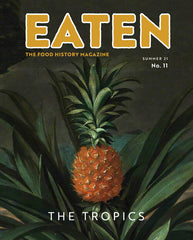Ever since I was in college, I’ve always been really interested in all the crazy things people cooked and ate back in the day. I actually wrote my undergraduate thesis on the history of eating chicken in the United States, which eventually became a book called Tastes Like Chicken (obviously there was no other possible name for it). When I worked as a freelance food writer, I always found myself drawn to the historical elements of whatever I was reporting on but it was really difficult to make purely historical writing timely and still good. At the time there was no real outlet for me to write regularly about food history that wasn’t a very formal academic publication so I decided to create my own. A kickstarter campaign and a baptism in fire in publishing later, here we are with Eaten.

Hurrah! How do you go about picking the themes, and how do you choose which stories go in?
I wish I had a more refined answer as to how I pick themes but its largely whatever randomly pops into my head and sticks there. (If a word has multiple meanings, that really helps it hang on.) As for stories, it’s all about the cohesion of the magazine as a whole, so I try to find a good balance between subject matter, geography, and time period. There is no magic formula as to what piece I will pick and what piece I won’t; if it feels right and is in balance with the rest of the edition, that’s what I will choose.
The design and especially the illustrations are so so good. What’s your inspiration for the look of the mag and who brings that to life?
I really appreciate having a sense of order and I think a lot of the reason why I enjoy the practice of history is that it involves much less creativity that the rest of the humanities. The building blocks are all already there for you to work with; you just have to find them and rearrange them in a way that makes the most sense. This is exactly how I approach the visuals of Eaten, almost 90% of which come from the public domain. I spend a lot of time going through archives just to see what’s there and when I find beautiful imagery I flag it, hoping that one day these will be useful to illustrate a future Eaten piece.
What other indie mags are on your coffee table?
I drink a lot of wine and am a big fan of Noble Rot; I’ve been moving houses a lot lately and that’s the only magazine I still currently subscribe too. I also really loved Gather Journal and am sad they no longer publish. The Gentlewoman too is also always a good escape. I try to pick up a copy anytime I see it in a newsstand.
Yes, love Noble Rot and The Gentlewoman. If you weren’t making Eaten, what would you be doing? (but please keep making Eaten)
To be perfectly honest, Eaten is technically my (very large and very time-consuming) side-hustle; my full-time job is as a PhD student studying history. If Eaten didn’t exist, I’d probably be doing the exact same thing, just in a much more academic and probably less entertaining way.
Oh wow. The first PhD editor that we've interviewed for the blog! And finally, though everything is moving online, we couldn't be without print magazines. Why does print matter to you?
When I first came up with the idea of Eaten I considered making it an online publication but the thought of creating and maintain something like that just tired me out. The pace of digital publishing is relentless; everyone is expected to churn out more and more content at every hour of the day just to grab eyeballs and ad dollars. As a freelance writer I absolutely hated it. It made it feel like all the work I did didn’t really matter and would be rinsed out in the increasingly rapid news cycle.
I thought by moving to print it would ensure the magazine would be slower, smaller, and wonderfully self-contained. As I’ve gotten older and realized that I personally feel better when I spend less time on the internet, I really believe I made the right choice on this one. The magazine itself is not particularly up-to-the-moment in its content so each article can live in its printed home for perpetuity, ready to be read and admired whenever someone feels most comfortable. History takes ages to understand and write, so I wanted to make sure the medium that these stories were published in matched that slower, more thoughtful pace.
Thank you so much, Emelyn. You can buy No. 10 Greens, No. 11 The Tropics and No. 12 Party in the shop now...and we would definitely recommend all three. Here they are in all their glory...







Leave a comment (all fields required)